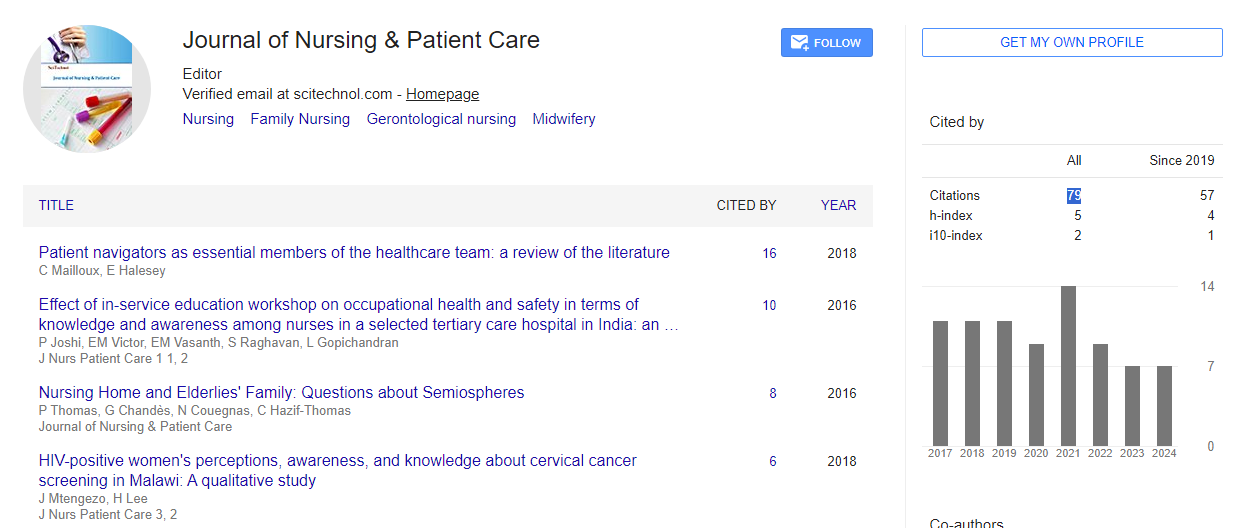Effectiveness of a multifactorial intervention for care providers to reduce physical restraints in nursing home
Liang Su-Hua , Huang and Tzu-Ting
Gung University, Taiwan
Jen-Teh Junior College of Medicine, Taiwan
Chang Gung University, Taiwan
: J Nurs Patient Care
Abstract
In Taiwanese nursing homes, the use of physical restraints on residents as a protective measure is fairly common. However, physical restraints can be seen as a violation of human rights, and there is no guarantee of the effectiveness or safety of such physical restraints. Scholars from around the world have been strongly advocating restraint-free care in long-term care institutions. Therefore, the aim of this study was to evaluate the effectiveness of a multifactorial intervention for care providers to reduce physical restraints in nursing homes. Method: A cluster randomized controlled trial was conducted using pretest-posttest control group design. A purposive sampling of participants was chosen from care providers of 4 nursing home institutions in Taiwan (n= 67), who were then randomly assigned to the experimental group (2 nursing homes, n= 33) or the control group (2 nursing homes, n= 34). The experimental group underwent multifactorial interventions to reduce physical restraint (including developing routines for physical restraint, promoting institutional policies to reduce the use of physical restraint, developing alternative methods, education, and consultations). Results: Care providers in the experimental group showed significant improvements in knowledge (p < .01), attitude (p < .05), and observed behavior (p < .05) posttest. Conclusion: Multifactorial interventions to reduce physical restraint are effective in improving the knowledge, attitude, and behavior of longterm care providers. Future implementation into clinical practice could improve the quality of nursing care. Reference: 1. Gulpers, M. J. M., M. H. C. Bleijlevens, E. Capezuti, E. V. Rossum, T. Ambergen and J. P. H. Hamers, 2012. Preventing belt restraint use in newly admitted residents in Nursing Homes: a quasi-experimental study. Int. J. Nurs. Stud., 49: 1473-1479 2. Gulpers, M. J. M., M. H. C. Bleijlevens, T. Ambergen, E. Capezuti, E. V. Rossum and J. P. H. Hamers, 2013. Reduction of belt restraint use: Long-term effects of the EXBELT intervention. J. Am. Geriatr Soc., 61: 107-112 3. Huang, H. C., Y. T. Huang, K. C. Lin and Y. F. Kuo, 2014. Risk factors associated with physical restraints in residential aged care facilities: a community- based epidemiological survey in Taiwan. J. Adv. Nurs., 70: 130-143 4. McCann, T. V., J. Baird and E. Muir-Cochrane, 2014. Attitudes of clinical staff toward the causes and management of aggression in acute old age psychiatry inpatient units. B. M. C. Psychiatry., 14: http://www.biomedcentral. com/1471-244X/14/80 5. Testad, I., T. E. Mekki, O. Førland, C. Øye, E. M. Tveit, F. Jacobsen and Ø. Kirkevold, 2016. Modeling and evaluating evidence-based continuing education program in nursing home dementia care (MEDCED)—training of care home staff to reduce use of restraint in care home residents with dementia. A cluster randomized controlled trial. Int. J. Geriatr. Psychiatry., 31: 24-32
Biography
Su-Hua Liang, MSN, RN, is a PhD student, Graduate Institute of Clinical Medical Sciences, School of Nursing, Chang Gung University, Tao-Yuan, Taiwan. She has published more than 3 papers in reputed journals and has experience giving oral presentation in nursing meetings. m8804204@gmail.com thuang@mail.cgu.edu.tw
 Spanish
Spanish  Chinese
Chinese  Russian
Russian  German
German  French
French  Japanese
Japanese  Portuguese
Portuguese  Hindi
Hindi 